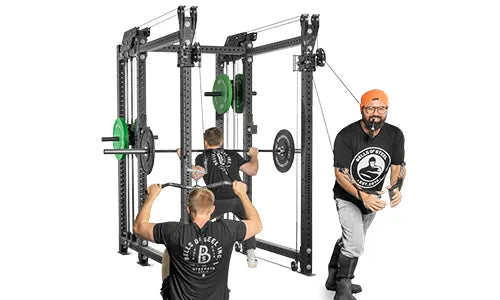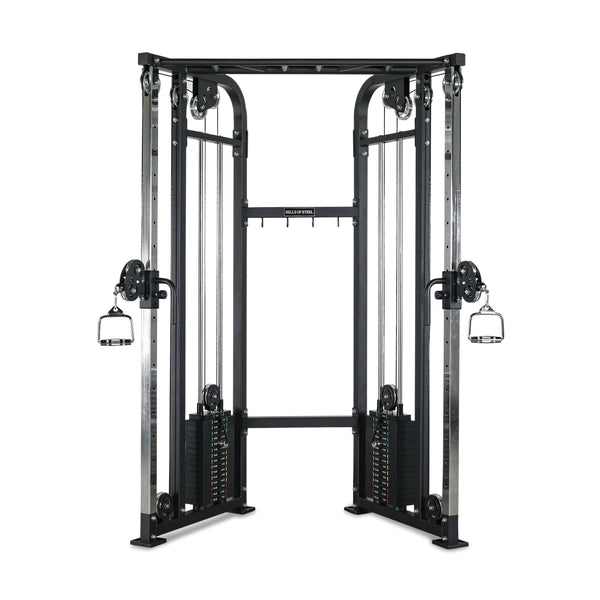If you’re debating between adding a cable system to your power rack or going all in on a standalone cable machine, welcome to the battle of the beasts. One is a space-saving, all-in-one powerhouse, while the other is a dedicated machine built for buttery-smooth cable action.
So which one wins? That depends on your space, budget, and how deep your love for cable exercises runs. Let’s break it down.
Power Rack with a Cable System: The Jack-of-All-Trades Setup
A power rack with an integrated cable system—like the Bells of Steel Kraken—is the Swiss Army knife of home gym setups. It transforms your rack from a squat-and-bench station into a full-on functional trainer, letting you go from barbell back squats to tricep pushdowns without skipping a beat.
Pros of a Power Rack with a Cable System
- Space-efficient: Takes up no extra footprint since it fits inside your rack.
- Versatile: Use it for lat pulldowns, rows, curls, triceps, and more—all within the same setup.
- Cost-effective: Typically cheaper than buying a full standalone cable machine (depending on a lot of variables, granted).
- Customizable: Choose between plate-loaded or weight stack options to fit your training style.
- Perfect for home gyms: No need for a second giant piece of equipment eating up floor space.
Cons of a Power Rack with a Cable System
- Not as smooth as a dedicated machine: A rack-mounted system is solid, but a standalone machine usually has the edge in pulley smoothness. Again, it depends on the setup.
- May not have dual pulleys: Some systems have a single pulley setup, meaning no true crossover movements unless you get a dual setup.
- Requires a power rack: If you don’t already have a power rack, this option is off the table (unless you want to go shopping, which—let’s be real—you probably do).
- May be too much for cable connoisseurs: If you’re more into cable training and free weights, then a power rack might not be suitable for your home gym, which makes all of this pretty superfluous, dontcha think?
Standalone Cable Machine: The Ultimate in Pulley Precision
Standalone cable machines are the OG functional trainers—built solely for smooth, consistent cable movement. They come in all shapes and sizes, from single-stack lat pulldown machines to full dual-stack functional trainers.
Pros of a Standalone Cable Machine
- Superior pulley feel: Expect smoother movement and less friction than a rack-mounted system. Add Aluminimum Wheels for even more buttery smoothness.
- More exercise variety: Many machines allow for true cable crossovers, dual-pulley movements, and adjustable arms. Our Cable Towers are also compatible with rack attachments, so there’s that. (Shameless plug).
- Independent weight stacks: If you go with a dual-stack machine, you can train unilateral movements with different loads on each side.
- Great for serious cable work: If you’re all about cables over barbells, this is your dream setup.
Cons of a Standalone Cable Machine
- Takes up more space: Unlike a rack-mounted system, a full-sized cable machine needs dedicated floor space. We do recommend the Cable Tower for a space-savvy option. Itty bitty footprint, big gains.
- Can be More expensive: You’re paying for that smooth pulley action and premium build. Of course, this depends on the option.
- Less barbell integration: Unlike a power rack with a cable system, you’re not squatting or benching on this bad boy—strictly cables only.
Plate-Loaded vs. Weight Stack: Which One Should You Choose?
Whether you go with a rack-mounted cable system or a standalone machine, you’ll need to decide between plate-loaded or weight stack resistance.
Plate-Loaded Cables: The Budget-Friendly Workhorse
- Uses the weight plates you already own
- Cheaper upfront cost
- Can go as heavy as you want (if you have enough plates)
- Changing weight takes more effort (hello, manual loading)
- Not as smooth as a weight stack
- May feel claustrophobic in a power rack setup
Weight Stack Cables: The Smooth Operator
- Super fast weight changes (just move the pin—done)
- Smoother and more consistent resistance
- Feels like a commercial gym machine
- Higher cost upfront
- Weight is capped (you can’t just add more plates), but how much do you lift, pal?
Which One Is Best for You?
Go with a Power Rack + Cable System if...
- You have limited space and want an all-in-one setup.
- You train both barbell and cable movements.
- You want a budget-friendly solution with room for customization.
- You like the idea of adding attachments like a lat pulldown seat or low row footplate.
Go with a Standalone Cable Machine if...
- You have space to spare and want the best pulley experience possible.
- You train a ton of cable-based movements (cable crossovers, unilateral work, etc.).
- You want dual independent weight stacks for balanced training.
- You don’t mind dedicating a section of your home gym to one piece of equipment.
Power Rack vs Standalone Cable Machine FAQs
Is a power rack with cables as good as a standalone cable machine?
It depends. A power rack with a cable system is more space-efficient and versatile, while a standalone cable machine offers smoother resistance and more exercise variety.
Can I do lat pulldowns and rows with a rack-mounted cable system?
Absolutely. Many rack-mounted cable systems, like the Bells of Steel Kraken, offer lat pulldown and low row capabilities with the right attachments.
Are plate-loaded cables worth it?
If you're on a budget, yes. They use your existing weight plates and let you load as much as you want. If you prefer quick weight changes and ultra-smooth resistance, weight stacks are better.
Can I do crossover exercises on a rack-mounted cable system?
Not always. Some rack-mounted systems only have a single pulley, so you won’t get true cable crossovers unless you install dual pulleys on each side of the rack.
Do I need both a power rack cable system and a standalone cable machine?
Unless you’re opening a home gym supercenter, probably not. Pick the one that fits your training style and space best.
Final Verdict: Which One Should You Choose?
The power rack with a cable system is king for space-saving versatility, giving you both barbell and cable training in one spot. But if you’re a die-hard cable lover and have the space, a standalone cable machine wins on smoothness, exercise variety, and ease of use.
Want the best of both worlds? Check out the Bells of Steel Kraken Rack-Mounted Cable System or our full lineup of standalone functional trainers.



